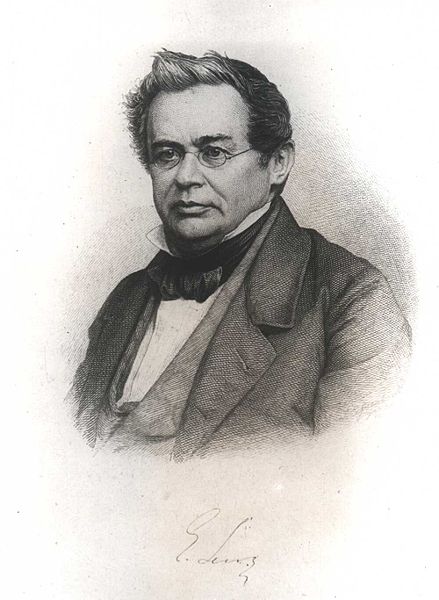<Back to Index>
- Physicist Heinrich Friedrich Emil Lenz, 1804
- Painter Ferdinand de Braekeleer the Elder, 1792
- Chairman of the Joint Chiefs of Staff General Omar Nelson Bradley, 1893
PAGE SPONSOR

Heinrich Friedrich Emil Lenz (Russian: Эмилий Христианович Ленц) (February 12, 1804 – February 10, 1865) was a Russian physicist of Baltic German ethnicity. He is most noted for formulating Lenz's law in electrodynamics in 1833.
Lenz was born in Dorpat (now Tartu), the Governorate of Livonia, in the Russian Empire at that time. After completing his secondary education in 1820, Lenz studied chemistry and physics at the University of Dorpat. He traveled with the navigator Otto von Kotzebue on his third expedition around the world from 1823 to 1826. On the voyage Lenz studied climatic conditions and the physical properties of seawater. The results have been published in "Memoirs of the St. Petersburg Academy of Sciences" (1831).
After the voyage, Lenz began working at the University of St. Petersburg, Russia, where he later served as the Dean of Mathematics and Physics from 1840 to 1863 and was Rector from 1863 until his death in 1865. Lenz also taught at the Petrischule in 1830 and 1831, and at the Mikhailovskaya Artillery Academy.
Lenz had begun studying electromagnetism in 1831. Besides the law named in his honor, Lenz also independently discovered Joule's law in 1842; to honor his efforts on the problem, it is also given the name the "Joule – Lenz law," named also for James Prescott Joule.
Lenz eagerly participated in the development of the electroplating technology, invented by his friend and colleague Moritz von Jacobi. In 1839 Lenz produced several medallions using electrotyping. Along with the electrotyped relief produced by Jacobi the same year, these were the first instances of galvanoplastic sculpture.
Lenz died in Rome, Italy, after suffering from a stroke.